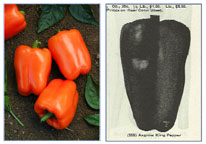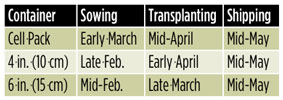10/26/2012
Growing Perfectly Pleasing Bell Peppers
Heather Kibble
In recognition of All-America Selections 80th anniversary, GrowerTalks
is featuring a series of Culture Notes articles on previous AAS winners during 2012.
Gardens and gardeners have changed since the first bell pepper won the All-America selections award in 1935. Yet, our love for bell peppers has not waivered; AAS still receives entries and, indeed, declared a bell pepper winner in 2011. Trail results are just coming in for 2012. The 1935 winner, Asgrow King, is no longer being produced, but a 1967 winner, Bell Boy, can be found in almost every garden center in the country. The 2011 winner, Orange Blaze, proves that bell peppers come in many colors and that seed producers are constantly improving flavor, disease resistance and earliness for the home garden.
What will future years hold for bell pepper breeding? Be on the lookout for fun colors. Many people don’t realize that sweet bells come in many colors—red, yellow, orange, chocolate, ivory and purple. All are sweet and flavorful in their own way. Other exciting trends in breeding are new shapes, sizes and plant habits. Another fun idea that breeders are working on is creating hot peppers without the heat—such as the jalapeño and habanero—so gardeners can have the wonderful flavor and scent of the classic hot peppers without the tongue-scorching heat.
Asgrow King from ASG (right) was the first bell pepper to win an AAS awa rd in 1935. Orange Blaze from Seminis (above) was the last winner in 2011.
rd in 1935. Orange Blaze from Seminis (above) was the last winner in 2011.
My division of Sakata, Sakata Home Grown, will be introducing three new mini sweet peppers for 2013-2014: Orange You Sweet, Right On Red and Yes to Yellow. All three are Hungarian cheese peppers (they’re shaped like little wheels of cheese) that mature to orange, red and yellow. They’re sweet, have a nice thick wall and can be served raw as a vessel for cool fillings (such as herbed cream cheese or tuna salad) or stuffed with traditional ground beef and baked as a main dish. We think they’ll be a hit with home gardeners for many reasons: the plants are early and ornamental; the fruit are colorful and unique; and the peppers are sweet and flat on the bottom so they’re a snap to fill.
Pepper seeds are easy to grow. Below are grower guidelines we have found to be useful.
Optimum germination temperature: 82 to 86F (28 to 30C) day; 64 to 68F (18 to 20C) night
Optimum growing temperature: 65 to 70F (18 to 21C)
Plug culture: 5 weeks (288 plug cell)
Stage 1 (Days 1 to 7): Use a well-drained media with a pH between 5.8 and 6.2 with a soil EC of 0.5 mmhos (1:2 slurry). Prior to sowing, water the plug tray to the point of drip. Then, sow the seed and lightly cover with medium vermiculite. Do not water after sowing or the day following sowing. Then, water the seedlings as needed allowing the media to dry slightly in between watering. An overly wet soil will decrease germination. It’s recommended to alternate the temperature targeting 82 to 86F (28 to 30C) during the day and 64 to 68F (18 to 20C) at night. Provide air humidity at 90%.
Stage 2 (Days 8 to 14): The cotyledons are now visible and roots are beginning to form. Reduce relative humidity and maintain an air temperature between 65 to 70F (18 to 21C). A light feeding at 50 to 75 ppm N from a well-balanced calcium nitrate-based formulation will strengthen the seedlings.
Stage 3 (Days 15 to 28): The first true leaves are developed and roots are beginning to penetrate the media. Allow the media to dry slightly between irrigations to promote healthy root development. Increase the fertilizer rate to 100 to 150 ppm N once or twice per week to maintain an EC level between 0.75 and 1.0. High fertilizer rates will have a negative impact on capsicum seedlings.
Stage 4 (Days 29 to 35): The plugs are now ready to transplant and should have 1 to 2 sets of true leaves. Reduce fertilizer to tone the seedlings and prepare them for transplanting.
Transplanting to shipping: 6 to 10 weeks
Containers: Cell packs and 4 in. (10 cm)
Med ia:
ia: Select a sterile and well-drained media with a pH between 5.5 and 6.3 and low in nutrients (EC level less than 1.0 mmhos).
Temperature: Optimum growing temperature is 70 to 75F (21 to 24C) during the day and 65F (18C) at night.
Fertilizer: Maintain the media EC between 1.0 to 1.5 mmhos (1:2 slurry) by applying 200 ppm N as needed from a well-balanced calcium nitrate-based formulation. The use of cal/mag formulations, like
15-5-15, work well to supply adequate amounts of magnesium. Excess fertilizer rates reduce flowering and fruit set.
Growth regulation: Space plants on time, reduce temperature to 60F (16C) and avoid over-fertilization; especially with ammonium-based fertilizer.
Lighting: Ornamental peppers tolerate high levels of light, which enhance the pigmentation of the fruit. Cool nights and warm days combined with plenty of direct sunlight produce the best crop.
Pests and diseases: Aphids and leaf spot
Crop Scheduling:
Cell packs: 9 to 10 weeks from sowing
Pots: 11 to 13 weeks from sowing
GT
Heather Kibble is Area Sales Manager for Sakata Home Grown based in Morgan Hill, California.